Digital Technologies: Transforming Teaching and Learning Practices
VerifiedAdded on 2023/04/21
|16
|5871
|479
Report
AI Summary
This report explores the transformative potential of digital technologies in education, focusing on virtual reality, classroom devices, redesigned learning spaces, artificial intelligence, personalized learning, and gamification. It identifies issues in implementing these technologies, such as professional development challenges, resistance to change, and the need for effective assessment methods. The report also discusses the implications for teaching practices, emphasizing personalized learning and two-way e-learning conversations. It references global leading practices and provides recommendations for effectively integrating digital technology into teaching to foster a smarter future. This student contributed document is available on Desklib, a platform offering a range of study tools for students.
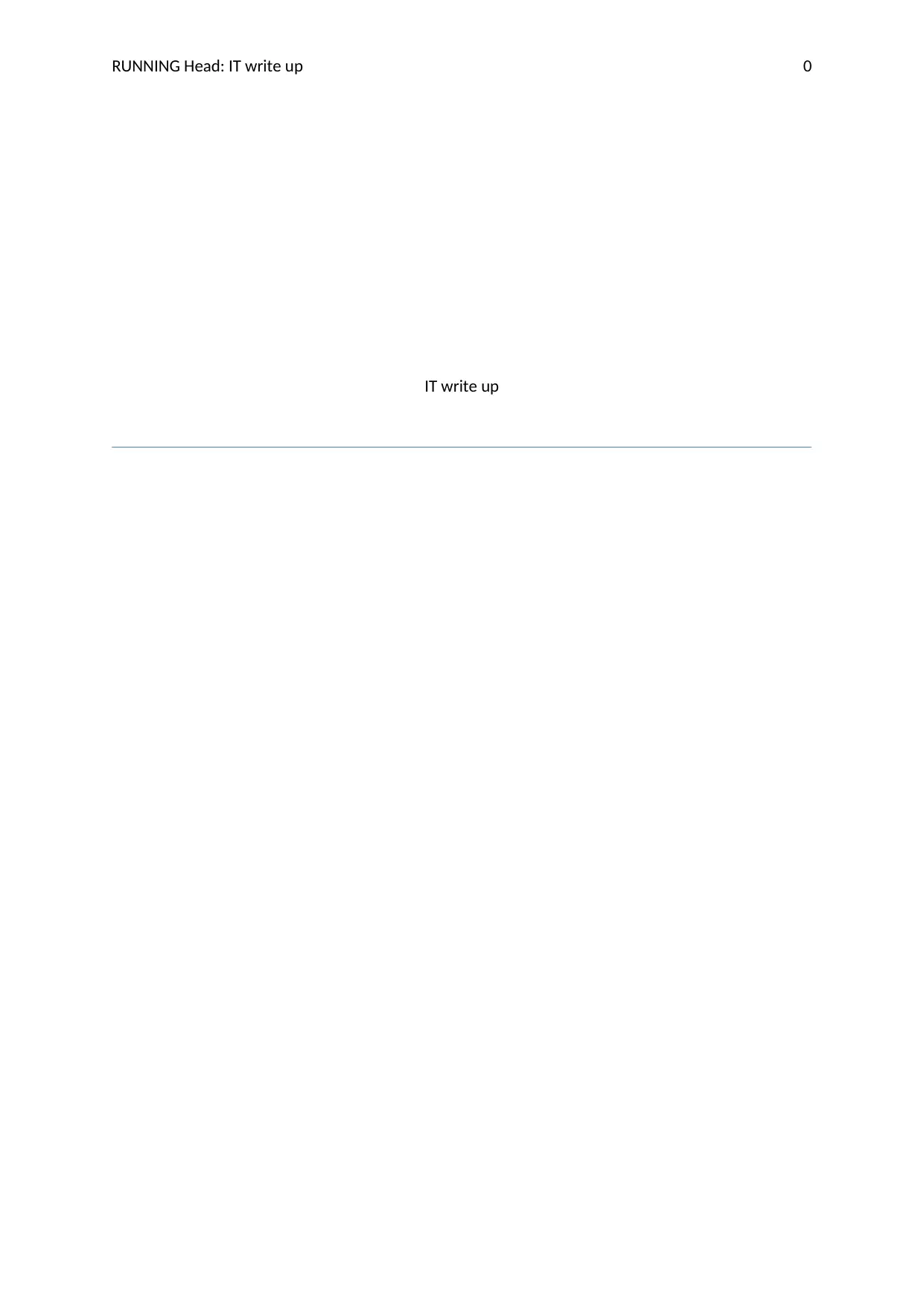
RUNNING Head: IT write up 0
IT write up
IT write up
Paraphrase This Document
Need a fresh take? Get an instant paraphrase of this document with our AI Paraphraser
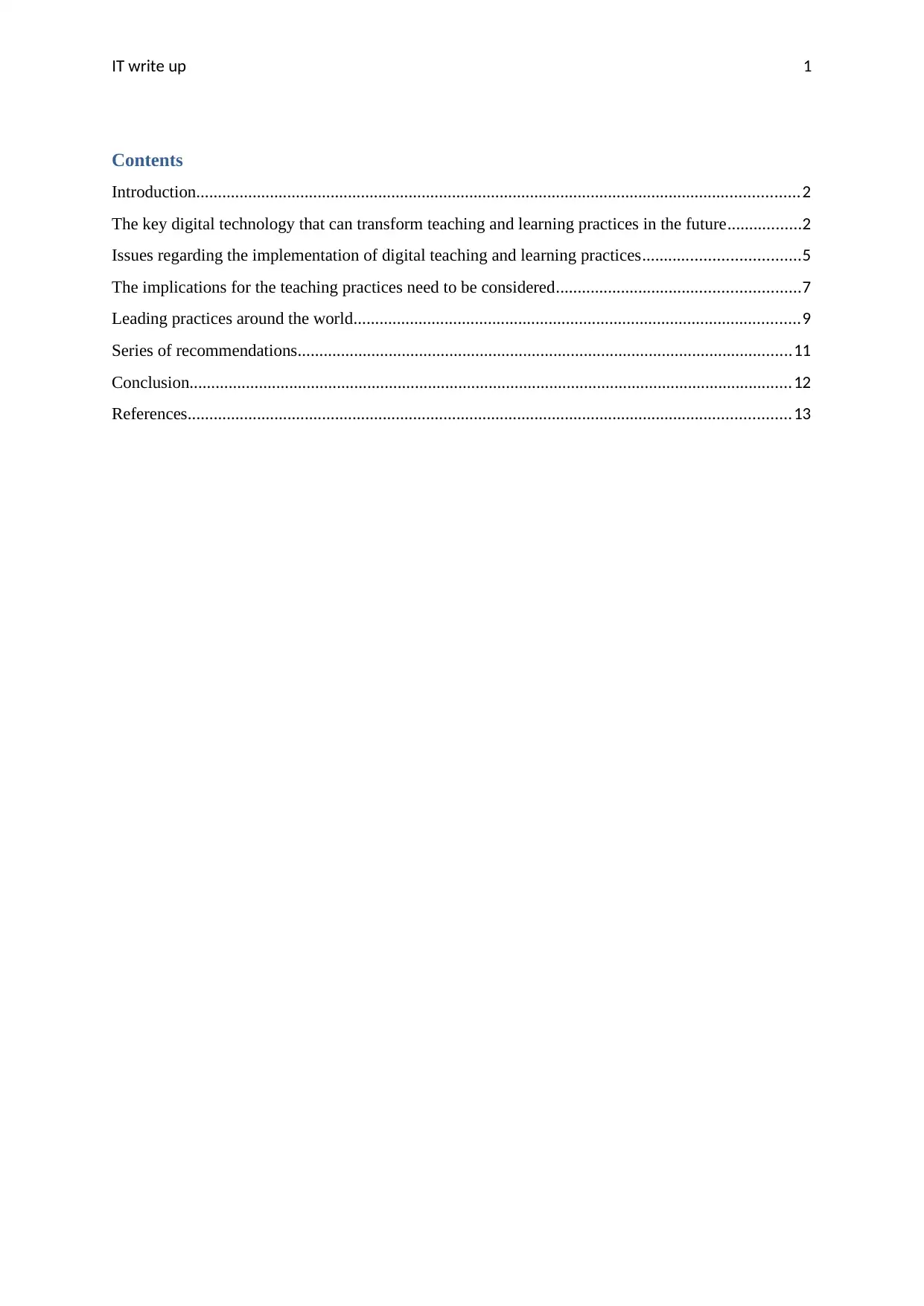
IT write up 1
Contents
Introduction...........................................................................................................................................2
The key digital technology that can transform teaching and learning practices in the future.................2
Issues regarding the implementation of digital teaching and learning practices....................................5
The implications for the teaching practices need to be considered........................................................7
Leading practices around the world.......................................................................................................9
Series of recommendations..................................................................................................................11
Conclusion...........................................................................................................................................12
References...........................................................................................................................................13
Contents
Introduction...........................................................................................................................................2
The key digital technology that can transform teaching and learning practices in the future.................2
Issues regarding the implementation of digital teaching and learning practices....................................5
The implications for the teaching practices need to be considered........................................................7
Leading practices around the world.......................................................................................................9
Series of recommendations..................................................................................................................11
Conclusion...........................................................................................................................................12
References...........................................................................................................................................13
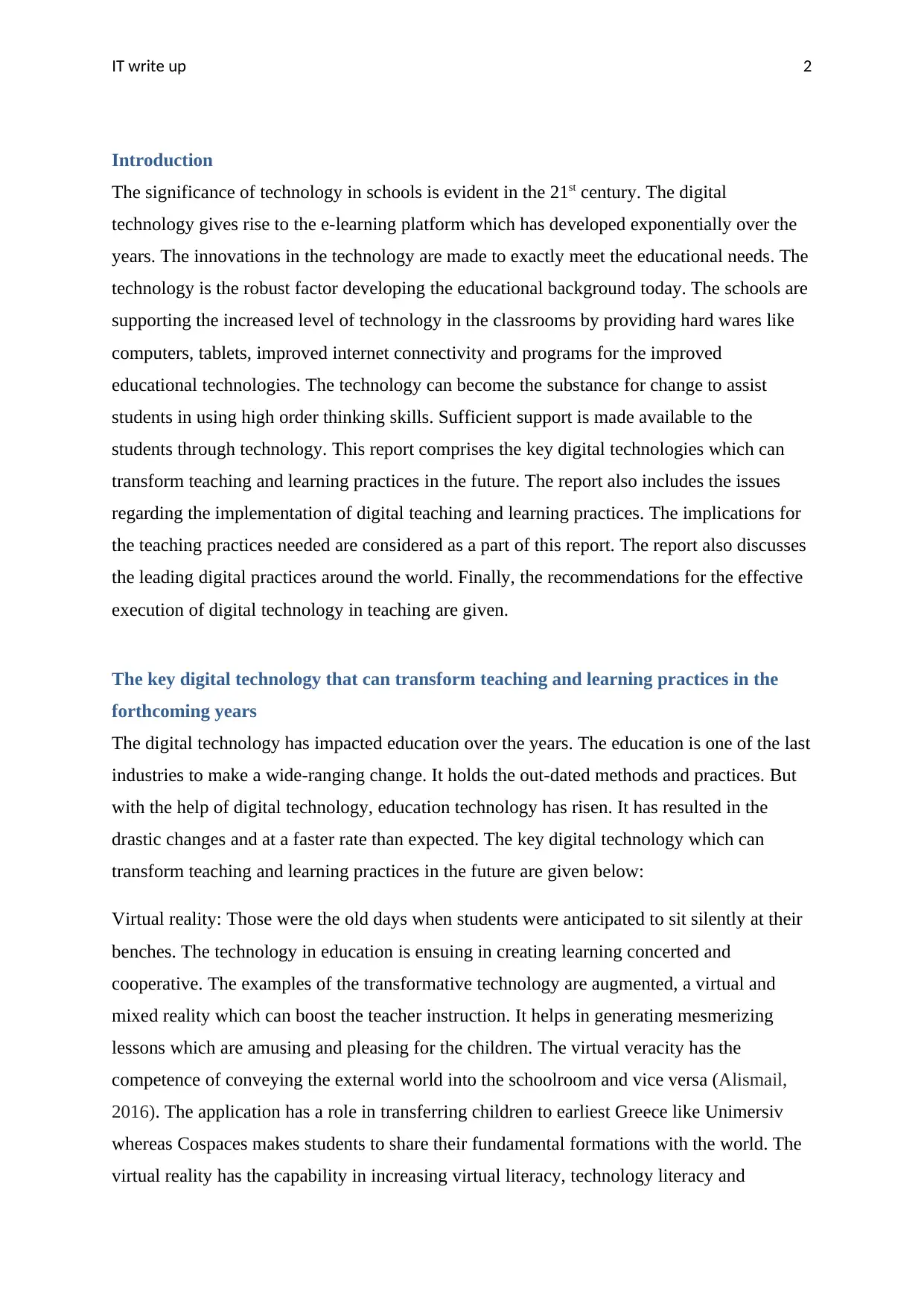
IT write up 2
Introduction
The significance of technology in schools is evident in the 21st century. The digital
technology gives rise to the e-learning platform which has developed exponentially over the
years. The innovations in the technology are made to exactly meet the educational needs. The
technology is the robust factor developing the educational background today. The schools are
supporting the increased level of technology in the classrooms by providing hard wares like
computers, tablets, improved internet connectivity and programs for the improved
educational technologies. The technology can become the substance for change to assist
students in using high order thinking skills. Sufficient support is made available to the
students through technology. This report comprises the key digital technologies which can
transform teaching and learning practices in the future. The report also includes the issues
regarding the implementation of digital teaching and learning practices. The implications for
the teaching practices needed are considered as a part of this report. The report also discusses
the leading digital practices around the world. Finally, the recommendations for the effective
execution of digital technology in teaching are given.
The key digital technology that can transform teaching and learning practices in the
forthcoming years
The digital technology has impacted education over the years. The education is one of the last
industries to make a wide-ranging change. It holds the out-dated methods and practices. But
with the help of digital technology, education technology has risen. It has resulted in the
drastic changes and at a faster rate than expected. The key digital technology which can
transform teaching and learning practices in the future are given below:
Virtual reality: Those were the old days when students were anticipated to sit silently at their
benches. The technology in education is ensuing in creating learning concerted and
cooperative. The examples of the transformative technology are augmented, a virtual and
mixed reality which can boost the teacher instruction. It helps in generating mesmerizing
lessons which are amusing and pleasing for the children. The virtual veracity has the
competence of conveying the external world into the schoolroom and vice versa (Alismail,
2016). The application has a role in transferring children to earliest Greece like Unimersiv
whereas Cospaces makes students to share their fundamental formations with the world. The
virtual reality has the capability in increasing virtual literacy, technology literacy and
Introduction
The significance of technology in schools is evident in the 21st century. The digital
technology gives rise to the e-learning platform which has developed exponentially over the
years. The innovations in the technology are made to exactly meet the educational needs. The
technology is the robust factor developing the educational background today. The schools are
supporting the increased level of technology in the classrooms by providing hard wares like
computers, tablets, improved internet connectivity and programs for the improved
educational technologies. The technology can become the substance for change to assist
students in using high order thinking skills. Sufficient support is made available to the
students through technology. This report comprises the key digital technologies which can
transform teaching and learning practices in the future. The report also includes the issues
regarding the implementation of digital teaching and learning practices. The implications for
the teaching practices needed are considered as a part of this report. The report also discusses
the leading digital practices around the world. Finally, the recommendations for the effective
execution of digital technology in teaching are given.
The key digital technology that can transform teaching and learning practices in the
forthcoming years
The digital technology has impacted education over the years. The education is one of the last
industries to make a wide-ranging change. It holds the out-dated methods and practices. But
with the help of digital technology, education technology has risen. It has resulted in the
drastic changes and at a faster rate than expected. The key digital technology which can
transform teaching and learning practices in the future are given below:
Virtual reality: Those were the old days when students were anticipated to sit silently at their
benches. The technology in education is ensuing in creating learning concerted and
cooperative. The examples of the transformative technology are augmented, a virtual and
mixed reality which can boost the teacher instruction. It helps in generating mesmerizing
lessons which are amusing and pleasing for the children. The virtual veracity has the
competence of conveying the external world into the schoolroom and vice versa (Alismail,
2016). The application has a role in transferring children to earliest Greece like Unimersiv
whereas Cospaces makes students to share their fundamental formations with the world. The
virtual reality has the capability in increasing virtual literacy, technology literacy and
⊘ This is a preview!⊘
Do you want full access?
Subscribe today to unlock all pages.

Trusted by 1+ million students worldwide
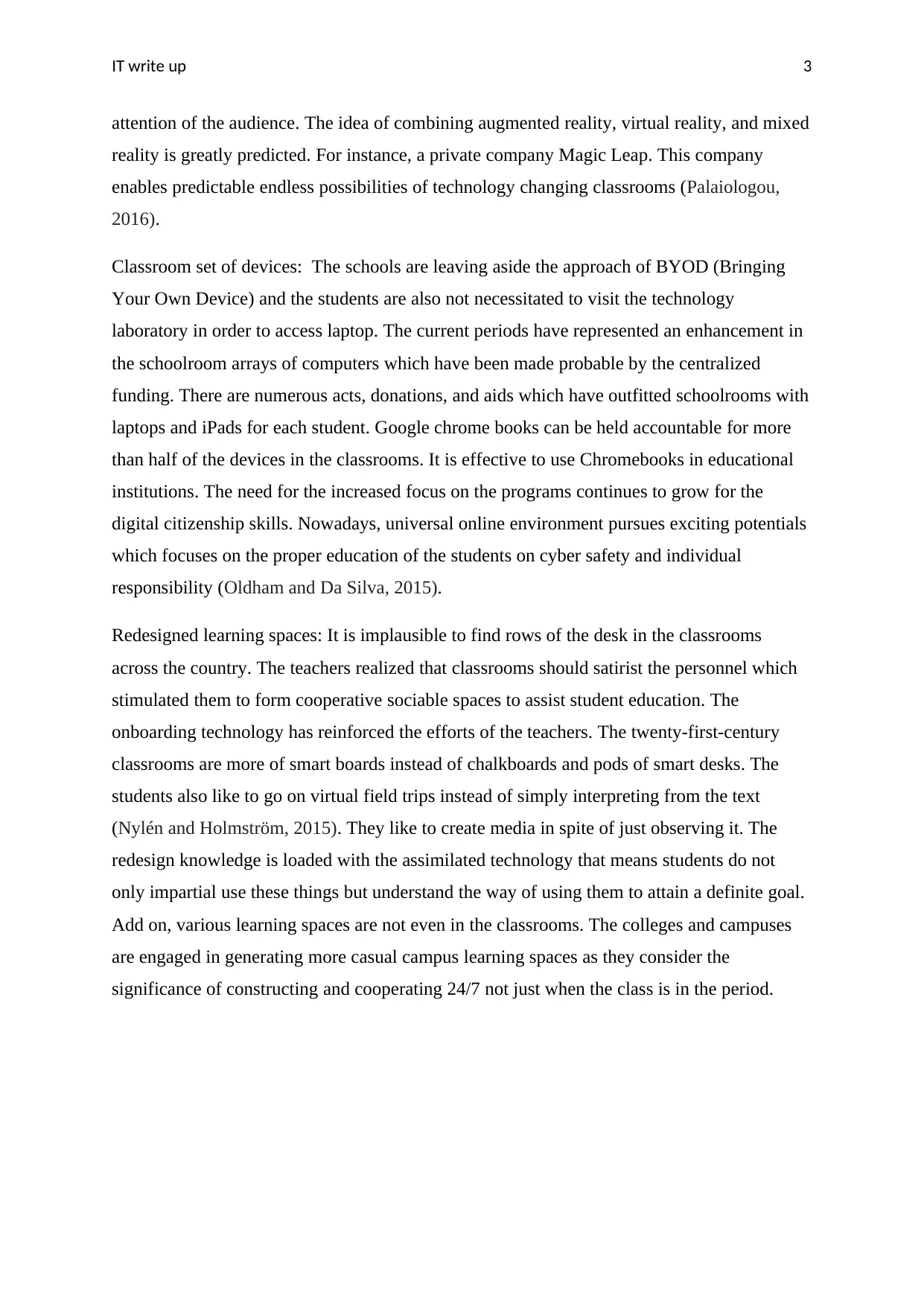
IT write up 3
attention of the audience. The idea of combining augmented reality, virtual reality, and mixed
reality is greatly predicted. For instance, a private company Magic Leap. This company
enables predictable endless possibilities of technology changing classrooms (Palaiologou,
2016).
Classroom set of devices: The schools are leaving aside the approach of BYOD (Bringing
Your Own Device) and the students are also not necessitated to visit the technology
laboratory in order to access laptop. The current periods have represented an enhancement in
the schoolroom arrays of computers which have been made probable by the centralized
funding. There are numerous acts, donations, and aids which have outfitted schoolrooms with
laptops and iPads for each student. Google chrome books can be held accountable for more
than half of the devices in the classrooms. It is effective to use Chromebooks in educational
institutions. The need for the increased focus on the programs continues to grow for the
digital citizenship skills. Nowadays, universal online environment pursues exciting potentials
which focuses on the proper education of the students on cyber safety and individual
responsibility (Oldham and Da Silva, 2015).
Redesigned learning spaces: It is implausible to find rows of the desk in the classrooms
across the country. The teachers realized that classrooms should satirist the personnel which
stimulated them to form cooperative sociable spaces to assist student education. The
onboarding technology has reinforced the efforts of the teachers. The twenty-first-century
classrooms are more of smart boards instead of chalkboards and pods of smart desks. The
students also like to go on virtual field trips instead of simply interpreting from the text
(Nylén and Holmström, 2015). They like to create media in spite of just observing it. The
redesign knowledge is loaded with the assimilated technology that means students do not
only impartial use these things but understand the way of using them to attain a definite goal.
Add on, various learning spaces are not even in the classrooms. The colleges and campuses
are engaged in generating more casual campus learning spaces as they consider the
significance of constructing and cooperating 24/7 not just when the class is in the period.
attention of the audience. The idea of combining augmented reality, virtual reality, and mixed
reality is greatly predicted. For instance, a private company Magic Leap. This company
enables predictable endless possibilities of technology changing classrooms (Palaiologou,
2016).
Classroom set of devices: The schools are leaving aside the approach of BYOD (Bringing
Your Own Device) and the students are also not necessitated to visit the technology
laboratory in order to access laptop. The current periods have represented an enhancement in
the schoolroom arrays of computers which have been made probable by the centralized
funding. There are numerous acts, donations, and aids which have outfitted schoolrooms with
laptops and iPads for each student. Google chrome books can be held accountable for more
than half of the devices in the classrooms. It is effective to use Chromebooks in educational
institutions. The need for the increased focus on the programs continues to grow for the
digital citizenship skills. Nowadays, universal online environment pursues exciting potentials
which focuses on the proper education of the students on cyber safety and individual
responsibility (Oldham and Da Silva, 2015).
Redesigned learning spaces: It is implausible to find rows of the desk in the classrooms
across the country. The teachers realized that classrooms should satirist the personnel which
stimulated them to form cooperative sociable spaces to assist student education. The
onboarding technology has reinforced the efforts of the teachers. The twenty-first-century
classrooms are more of smart boards instead of chalkboards and pods of smart desks. The
students also like to go on virtual field trips instead of simply interpreting from the text
(Nylén and Holmström, 2015). They like to create media in spite of just observing it. The
redesign knowledge is loaded with the assimilated technology that means students do not
only impartial use these things but understand the way of using them to attain a definite goal.
Add on, various learning spaces are not even in the classrooms. The colleges and campuses
are engaged in generating more casual campus learning spaces as they consider the
significance of constructing and cooperating 24/7 not just when the class is in the period.
Paraphrase This Document
Need a fresh take? Get an instant paraphrase of this document with our AI Paraphraser
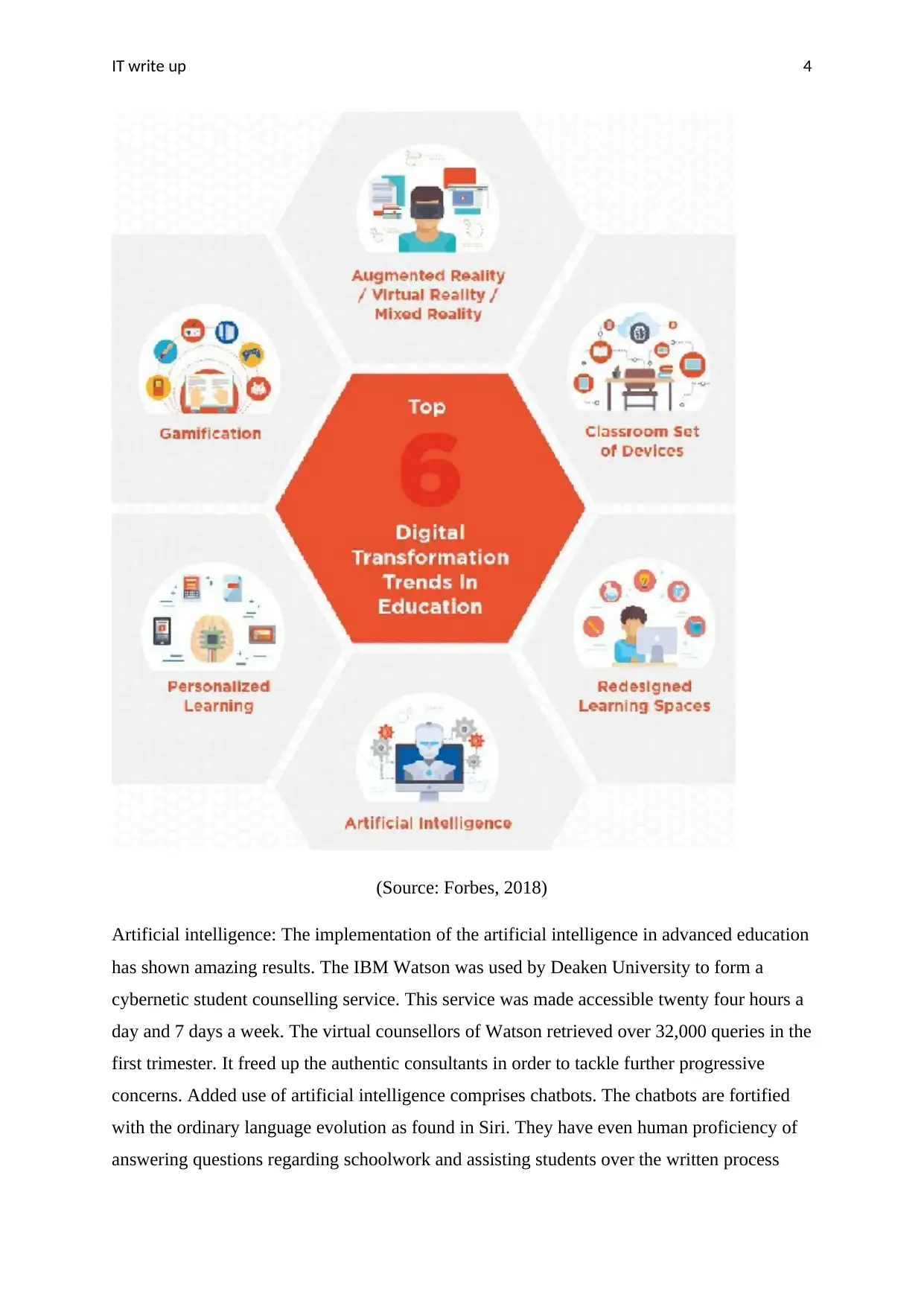
IT write up 4
(Source: Forbes, 2018)
Artificial intelligence: The implementation of the artificial intelligence in advanced education
has shown amazing results. The IBM Watson was used by Deaken University to form a
cybernetic student counselling service. This service was made accessible twenty four hours a
day and 7 days a week. The virtual counsellors of Watson retrieved over 32,000 queries in the
first trimester. It freed up the authentic consultants in order to tackle further progressive
concerns. Added use of artificial intelligence comprises chatbots. The chatbots are fortified
with the ordinary language evolution as found in Siri. They have even human proficiency of
answering questions regarding schoolwork and assisting students over the written process
(Source: Forbes, 2018)
Artificial intelligence: The implementation of the artificial intelligence in advanced education
has shown amazing results. The IBM Watson was used by Deaken University to form a
cybernetic student counselling service. This service was made accessible twenty four hours a
day and 7 days a week. The virtual counsellors of Watson retrieved over 32,000 queries in the
first trimester. It freed up the authentic consultants in order to tackle further progressive
concerns. Added use of artificial intelligence comprises chatbots. The chatbots are fortified
with the ordinary language evolution as found in Siri. They have even human proficiency of
answering questions regarding schoolwork and assisting students over the written process
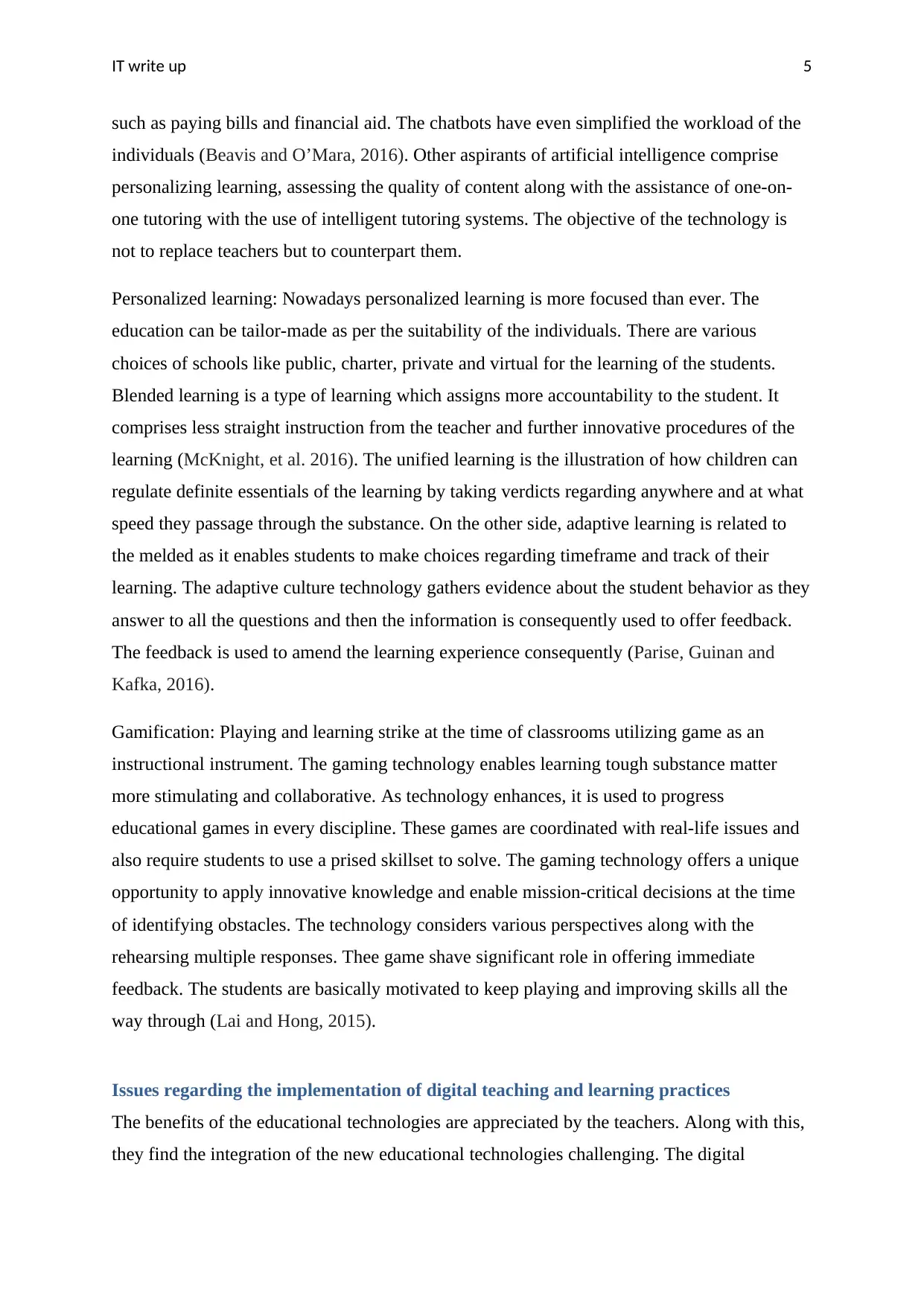
IT write up 5
such as paying bills and financial aid. The chatbots have even simplified the workload of the
individuals (Beavis and O’Mara, 2016). Other aspirants of artificial intelligence comprise
personalizing learning, assessing the quality of content along with the assistance of one-on-
one tutoring with the use of intelligent tutoring systems. The objective of the technology is
not to replace teachers but to counterpart them.
Personalized learning: Nowadays personalized learning is more focused than ever. The
education can be tailor-made as per the suitability of the individuals. There are various
choices of schools like public, charter, private and virtual for the learning of the students.
Blended learning is a type of learning which assigns more accountability to the student. It
comprises less straight instruction from the teacher and further innovative procedures of the
learning (McKnight, et al. 2016). The unified learning is the illustration of how children can
regulate definite essentials of the learning by taking verdicts regarding anywhere and at what
speed they passage through the substance. On the other side, adaptive learning is related to
the melded as it enables students to make choices regarding timeframe and track of their
learning. The adaptive culture technology gathers evidence about the student behavior as they
answer to all the questions and then the information is consequently used to offer feedback.
The feedback is used to amend the learning experience consequently (Parise, Guinan and
Kafka, 2016).
Gamification: Playing and learning strike at the time of classrooms utilizing game as an
instructional instrument. The gaming technology enables learning tough substance matter
more stimulating and collaborative. As technology enhances, it is used to progress
educational games in every discipline. These games are coordinated with real-life issues and
also require students to use a prised skillset to solve. The gaming technology offers a unique
opportunity to apply innovative knowledge and enable mission-critical decisions at the time
of identifying obstacles. The technology considers various perspectives along with the
rehearsing multiple responses. Thee game shave significant role in offering immediate
feedback. The students are basically motivated to keep playing and improving skills all the
way through (Lai and Hong, 2015).
Issues regarding the implementation of digital teaching and learning practices
The benefits of the educational technologies are appreciated by the teachers. Along with this,
they find the integration of the new educational technologies challenging. The digital
such as paying bills and financial aid. The chatbots have even simplified the workload of the
individuals (Beavis and O’Mara, 2016). Other aspirants of artificial intelligence comprise
personalizing learning, assessing the quality of content along with the assistance of one-on-
one tutoring with the use of intelligent tutoring systems. The objective of the technology is
not to replace teachers but to counterpart them.
Personalized learning: Nowadays personalized learning is more focused than ever. The
education can be tailor-made as per the suitability of the individuals. There are various
choices of schools like public, charter, private and virtual for the learning of the students.
Blended learning is a type of learning which assigns more accountability to the student. It
comprises less straight instruction from the teacher and further innovative procedures of the
learning (McKnight, et al. 2016). The unified learning is the illustration of how children can
regulate definite essentials of the learning by taking verdicts regarding anywhere and at what
speed they passage through the substance. On the other side, adaptive learning is related to
the melded as it enables students to make choices regarding timeframe and track of their
learning. The adaptive culture technology gathers evidence about the student behavior as they
answer to all the questions and then the information is consequently used to offer feedback.
The feedback is used to amend the learning experience consequently (Parise, Guinan and
Kafka, 2016).
Gamification: Playing and learning strike at the time of classrooms utilizing game as an
instructional instrument. The gaming technology enables learning tough substance matter
more stimulating and collaborative. As technology enhances, it is used to progress
educational games in every discipline. These games are coordinated with real-life issues and
also require students to use a prised skillset to solve. The gaming technology offers a unique
opportunity to apply innovative knowledge and enable mission-critical decisions at the time
of identifying obstacles. The technology considers various perspectives along with the
rehearsing multiple responses. Thee game shave significant role in offering immediate
feedback. The students are basically motivated to keep playing and improving skills all the
way through (Lai and Hong, 2015).
Issues regarding the implementation of digital teaching and learning practices
The benefits of the educational technologies are appreciated by the teachers. Along with this,
they find the integration of the new educational technologies challenging. The digital
⊘ This is a preview!⊘
Do you want full access?
Subscribe today to unlock all pages.

Trusted by 1+ million students worldwide
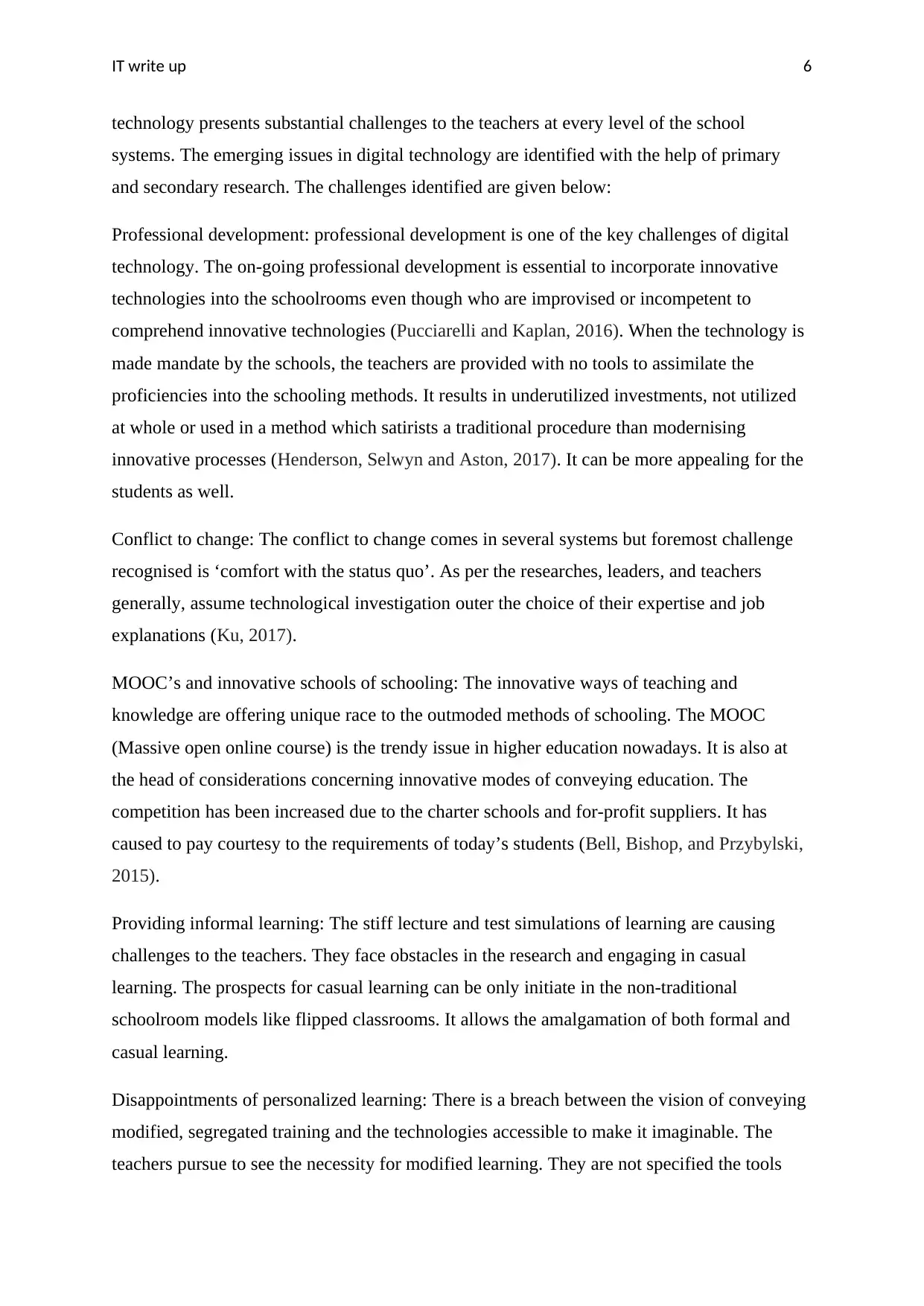
IT write up 6
technology presents substantial challenges to the teachers at every level of the school
systems. The emerging issues in digital technology are identified with the help of primary
and secondary research. The challenges identified are given below:
Professional development: professional development is one of the key challenges of digital
technology. The on-going professional development is essential to incorporate innovative
technologies into the schoolrooms even though who are improvised or incompetent to
comprehend innovative technologies (Pucciarelli and Kaplan, 2016). When the technology is
made mandate by the schools, the teachers are provided with no tools to assimilate the
proficiencies into the schooling methods. It results in underutilized investments, not utilized
at whole or used in a method which satirists a traditional procedure than modernising
innovative processes (Henderson, Selwyn and Aston, 2017). It can be more appealing for the
students as well.
Conflict to change: The conflict to change comes in several systems but foremost challenge
recognised is ‘comfort with the status quo’. As per the researches, leaders, and teachers
generally, assume technological investigation outer the choice of their expertise and job
explanations (Ku, 2017).
MOOC’s and innovative schools of schooling: The innovative ways of teaching and
knowledge are offering unique race to the outmoded methods of schooling. The MOOC
(Massive open online course) is the trendy issue in higher education nowadays. It is also at
the head of considerations concerning innovative modes of conveying education. The
competition has been increased due to the charter schools and for-profit suppliers. It has
caused to pay courtesy to the requirements of today’s students (Bell, Bishop, and Przybylski,
2015).
Providing informal learning: The stiff lecture and test simulations of learning are causing
challenges to the teachers. They face obstacles in the research and engaging in casual
learning. The prospects for casual learning can be only initiate in the non-traditional
schoolroom models like flipped classrooms. It allows the amalgamation of both formal and
casual learning.
Disappointments of personalized learning: There is a breach between the vision of conveying
modified, segregated training and the technologies accessible to make it imaginable. The
teachers pursue to see the necessity for modified learning. They are not specified the tools
technology presents substantial challenges to the teachers at every level of the school
systems. The emerging issues in digital technology are identified with the help of primary
and secondary research. The challenges identified are given below:
Professional development: professional development is one of the key challenges of digital
technology. The on-going professional development is essential to incorporate innovative
technologies into the schoolrooms even though who are improvised or incompetent to
comprehend innovative technologies (Pucciarelli and Kaplan, 2016). When the technology is
made mandate by the schools, the teachers are provided with no tools to assimilate the
proficiencies into the schooling methods. It results in underutilized investments, not utilized
at whole or used in a method which satirists a traditional procedure than modernising
innovative processes (Henderson, Selwyn and Aston, 2017). It can be more appealing for the
students as well.
Conflict to change: The conflict to change comes in several systems but foremost challenge
recognised is ‘comfort with the status quo’. As per the researches, leaders, and teachers
generally, assume technological investigation outer the choice of their expertise and job
explanations (Ku, 2017).
MOOC’s and innovative schools of schooling: The innovative ways of teaching and
knowledge are offering unique race to the outmoded methods of schooling. The MOOC
(Massive open online course) is the trendy issue in higher education nowadays. It is also at
the head of considerations concerning innovative modes of conveying education. The
competition has been increased due to the charter schools and for-profit suppliers. It has
caused to pay courtesy to the requirements of today’s students (Bell, Bishop, and Przybylski,
2015).
Providing informal learning: The stiff lecture and test simulations of learning are causing
challenges to the teachers. They face obstacles in the research and engaging in casual
learning. The prospects for casual learning can be only initiate in the non-traditional
schoolroom models like flipped classrooms. It allows the amalgamation of both formal and
casual learning.
Disappointments of personalized learning: There is a breach between the vision of conveying
modified, segregated training and the technologies accessible to make it imaginable. The
teachers pursue to see the necessity for modified learning. They are not specified the tools
Paraphrase This Document
Need a fresh take? Get an instant paraphrase of this document with our AI Paraphraser
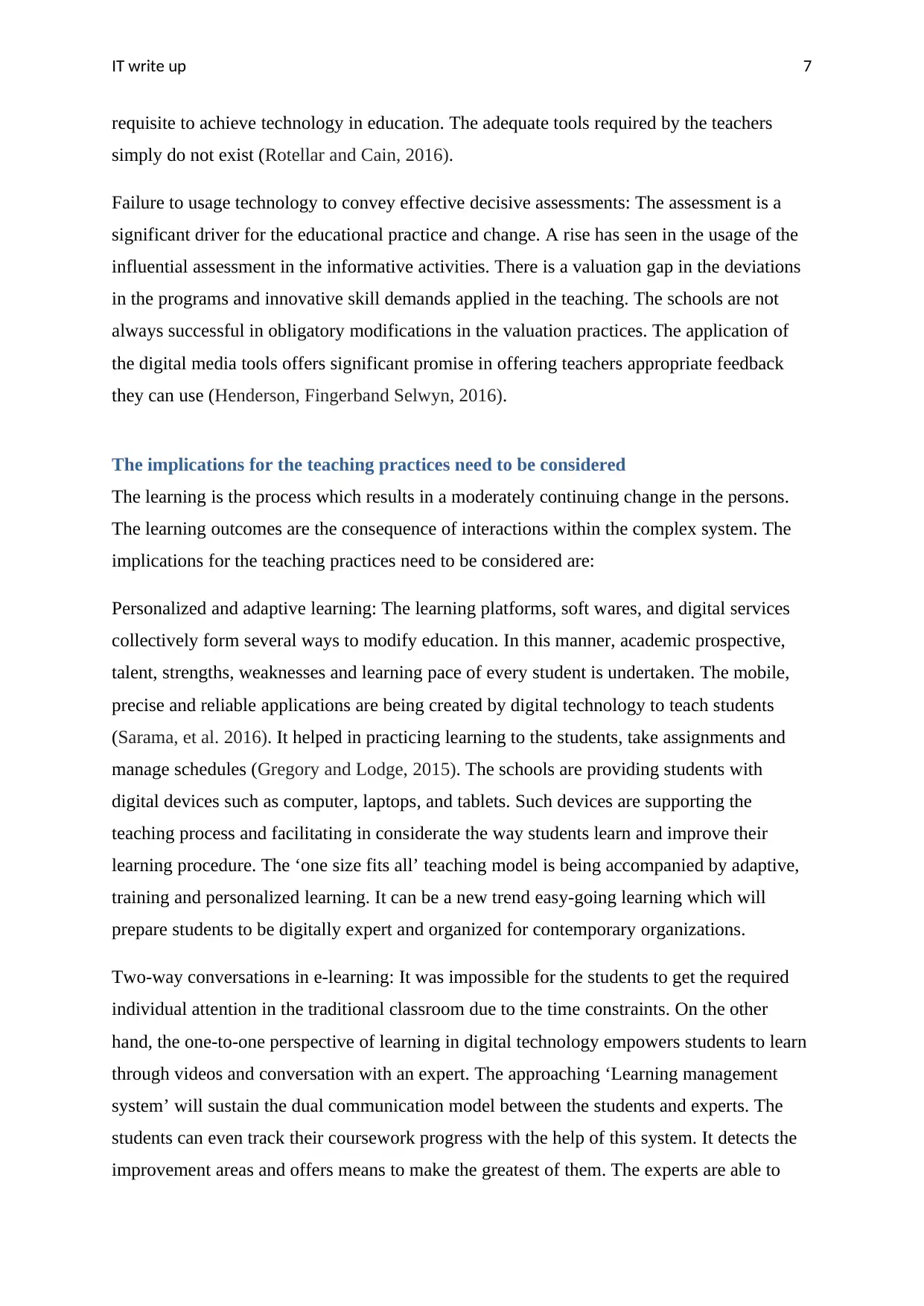
IT write up 7
requisite to achieve technology in education. The adequate tools required by the teachers
simply do not exist (Rotellar and Cain, 2016).
Failure to usage technology to convey effective decisive assessments: The assessment is a
significant driver for the educational practice and change. A rise has seen in the usage of the
influential assessment in the informative activities. There is a valuation gap in the deviations
in the programs and innovative skill demands applied in the teaching. The schools are not
always successful in obligatory modifications in the valuation practices. The application of
the digital media tools offers significant promise in offering teachers appropriate feedback
they can use (Henderson, Fingerband Selwyn, 2016).
The implications for the teaching practices need to be considered
The learning is the process which results in a moderately continuing change in the persons.
The learning outcomes are the consequence of interactions within the complex system. The
implications for the teaching practices need to be considered are:
Personalized and adaptive learning: The learning platforms, soft wares, and digital services
collectively form several ways to modify education. In this manner, academic prospective,
talent, strengths, weaknesses and learning pace of every student is undertaken. The mobile,
precise and reliable applications are being created by digital technology to teach students
(Sarama, et al. 2016). It helped in practicing learning to the students, take assignments and
manage schedules (Gregory and Lodge, 2015). The schools are providing students with
digital devices such as computer, laptops, and tablets. Such devices are supporting the
teaching process and facilitating in considerate the way students learn and improve their
learning procedure. The ‘one size fits all’ teaching model is being accompanied by adaptive,
training and personalized learning. It can be a new trend easy-going learning which will
prepare students to be digitally expert and organized for contemporary organizations.
Two-way conversations in e-learning: It was impossible for the students to get the required
individual attention in the traditional classroom due to the time constraints. On the other
hand, the one-to-one perspective of learning in digital technology empowers students to learn
through videos and conversation with an expert. The approaching ‘Learning management
system’ will sustain the dual communication model between the students and experts. The
students can even track their coursework progress with the help of this system. It detects the
improvement areas and offers means to make the greatest of them. The experts are able to
requisite to achieve technology in education. The adequate tools required by the teachers
simply do not exist (Rotellar and Cain, 2016).
Failure to usage technology to convey effective decisive assessments: The assessment is a
significant driver for the educational practice and change. A rise has seen in the usage of the
influential assessment in the informative activities. There is a valuation gap in the deviations
in the programs and innovative skill demands applied in the teaching. The schools are not
always successful in obligatory modifications in the valuation practices. The application of
the digital media tools offers significant promise in offering teachers appropriate feedback
they can use (Henderson, Fingerband Selwyn, 2016).
The implications for the teaching practices need to be considered
The learning is the process which results in a moderately continuing change in the persons.
The learning outcomes are the consequence of interactions within the complex system. The
implications for the teaching practices need to be considered are:
Personalized and adaptive learning: The learning platforms, soft wares, and digital services
collectively form several ways to modify education. In this manner, academic prospective,
talent, strengths, weaknesses and learning pace of every student is undertaken. The mobile,
precise and reliable applications are being created by digital technology to teach students
(Sarama, et al. 2016). It helped in practicing learning to the students, take assignments and
manage schedules (Gregory and Lodge, 2015). The schools are providing students with
digital devices such as computer, laptops, and tablets. Such devices are supporting the
teaching process and facilitating in considerate the way students learn and improve their
learning procedure. The ‘one size fits all’ teaching model is being accompanied by adaptive,
training and personalized learning. It can be a new trend easy-going learning which will
prepare students to be digitally expert and organized for contemporary organizations.
Two-way conversations in e-learning: It was impossible for the students to get the required
individual attention in the traditional classroom due to the time constraints. On the other
hand, the one-to-one perspective of learning in digital technology empowers students to learn
through videos and conversation with an expert. The approaching ‘Learning management
system’ will sustain the dual communication model between the students and experts. The
students can even track their coursework progress with the help of this system. It detects the
improvement areas and offers means to make the greatest of them. The experts are able to
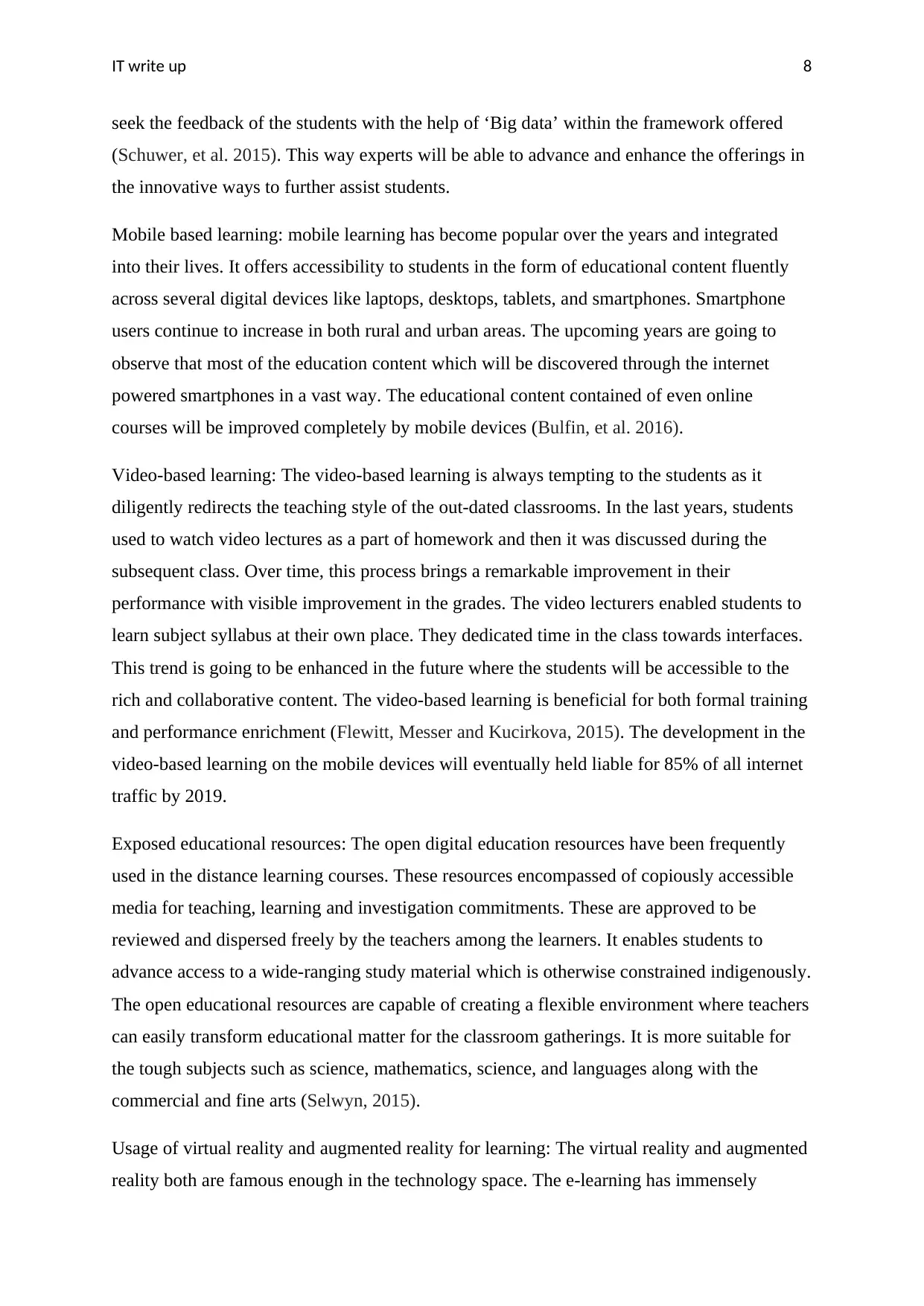
IT write up 8
seek the feedback of the students with the help of ‘Big data’ within the framework offered
(Schuwer, et al. 2015). This way experts will be able to advance and enhance the offerings in
the innovative ways to further assist students.
Mobile based learning: mobile learning has become popular over the years and integrated
into their lives. It offers accessibility to students in the form of educational content fluently
across several digital devices like laptops, desktops, tablets, and smartphones. Smartphone
users continue to increase in both rural and urban areas. The upcoming years are going to
observe that most of the education content which will be discovered through the internet
powered smartphones in a vast way. The educational content contained of even online
courses will be improved completely by mobile devices (Bulfin, et al. 2016).
Video-based learning: The video-based learning is always tempting to the students as it
diligently redirects the teaching style of the out-dated classrooms. In the last years, students
used to watch video lectures as a part of homework and then it was discussed during the
subsequent class. Over time, this process brings a remarkable improvement in their
performance with visible improvement in the grades. The video lecturers enabled students to
learn subject syllabus at their own place. They dedicated time in the class towards interfaces.
This trend is going to be enhanced in the future where the students will be accessible to the
rich and collaborative content. The video-based learning is beneficial for both formal training
and performance enrichment (Flewitt, Messer and Kucirkova, 2015). The development in the
video-based learning on the mobile devices will eventually held liable for 85% of all internet
traffic by 2019.
Exposed educational resources: The open digital education resources have been frequently
used in the distance learning courses. These resources encompassed of copiously accessible
media for teaching, learning and investigation commitments. These are approved to be
reviewed and dispersed freely by the teachers among the learners. It enables students to
advance access to a wide-ranging study material which is otherwise constrained indigenously.
The open educational resources are capable of creating a flexible environment where teachers
can easily transform educational matter for the classroom gatherings. It is more suitable for
the tough subjects such as science, mathematics, science, and languages along with the
commercial and fine arts (Selwyn, 2015).
Usage of virtual reality and augmented reality for learning: The virtual reality and augmented
reality both are famous enough in the technology space. The e-learning has immensely
seek the feedback of the students with the help of ‘Big data’ within the framework offered
(Schuwer, et al. 2015). This way experts will be able to advance and enhance the offerings in
the innovative ways to further assist students.
Mobile based learning: mobile learning has become popular over the years and integrated
into their lives. It offers accessibility to students in the form of educational content fluently
across several digital devices like laptops, desktops, tablets, and smartphones. Smartphone
users continue to increase in both rural and urban areas. The upcoming years are going to
observe that most of the education content which will be discovered through the internet
powered smartphones in a vast way. The educational content contained of even online
courses will be improved completely by mobile devices (Bulfin, et al. 2016).
Video-based learning: The video-based learning is always tempting to the students as it
diligently redirects the teaching style of the out-dated classrooms. In the last years, students
used to watch video lectures as a part of homework and then it was discussed during the
subsequent class. Over time, this process brings a remarkable improvement in their
performance with visible improvement in the grades. The video lecturers enabled students to
learn subject syllabus at their own place. They dedicated time in the class towards interfaces.
This trend is going to be enhanced in the future where the students will be accessible to the
rich and collaborative content. The video-based learning is beneficial for both formal training
and performance enrichment (Flewitt, Messer and Kucirkova, 2015). The development in the
video-based learning on the mobile devices will eventually held liable for 85% of all internet
traffic by 2019.
Exposed educational resources: The open digital education resources have been frequently
used in the distance learning courses. These resources encompassed of copiously accessible
media for teaching, learning and investigation commitments. These are approved to be
reviewed and dispersed freely by the teachers among the learners. It enables students to
advance access to a wide-ranging study material which is otherwise constrained indigenously.
The open educational resources are capable of creating a flexible environment where teachers
can easily transform educational matter for the classroom gatherings. It is more suitable for
the tough subjects such as science, mathematics, science, and languages along with the
commercial and fine arts (Selwyn, 2015).
Usage of virtual reality and augmented reality for learning: The virtual reality and augmented
reality both are famous enough in the technology space. The e-learning has immensely
⊘ This is a preview!⊘
Do you want full access?
Subscribe today to unlock all pages.

Trusted by 1+ million students worldwide
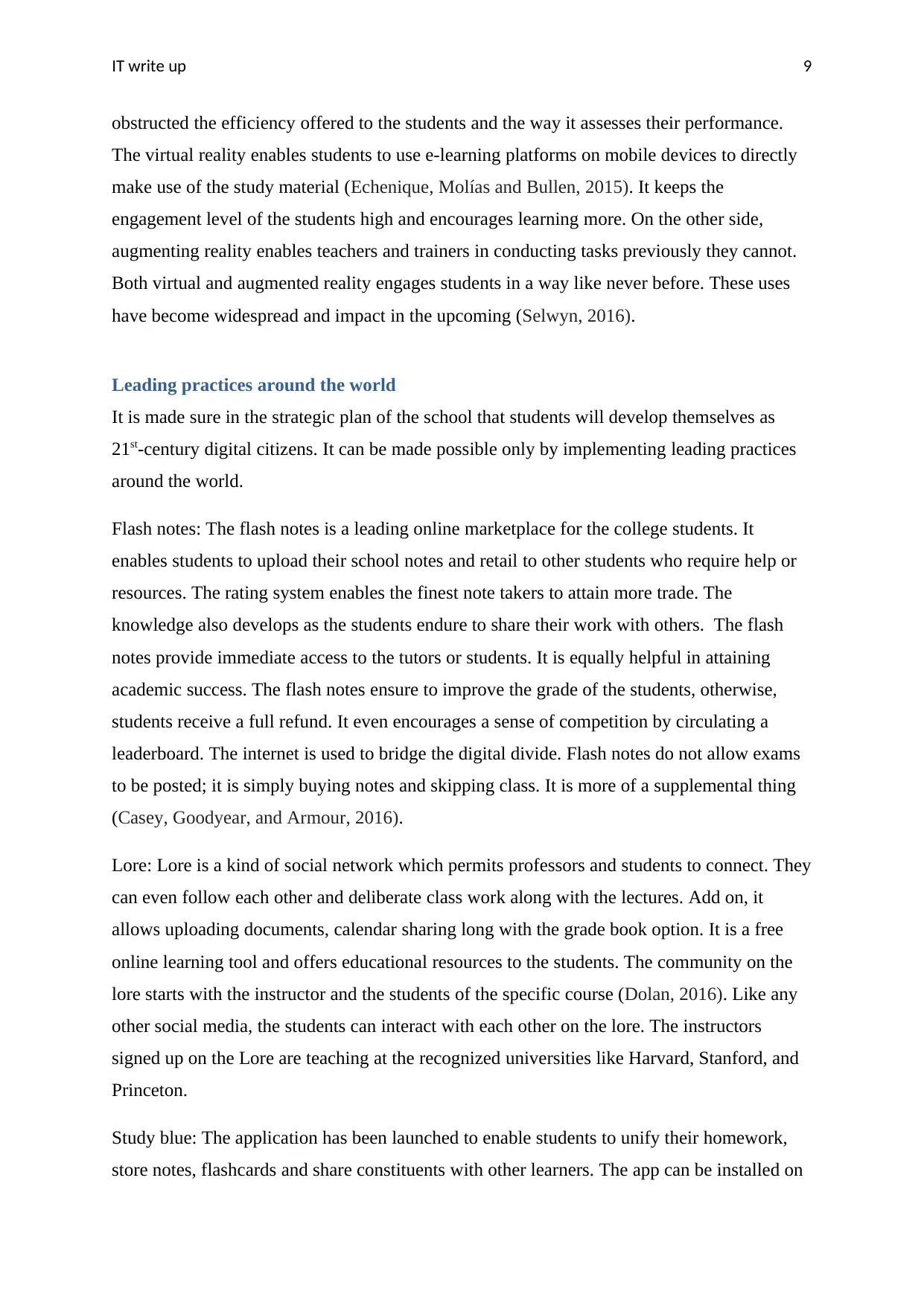
IT write up 9
obstructed the efficiency offered to the students and the way it assesses their performance.
The virtual reality enables students to use e-learning platforms on mobile devices to directly
make use of the study material (Echenique, Molías and Bullen, 2015). It keeps the
engagement level of the students high and encourages learning more. On the other side,
augmenting reality enables teachers and trainers in conducting tasks previously they cannot.
Both virtual and augmented reality engages students in a way like never before. These uses
have become widespread and impact in the upcoming (Selwyn, 2016).
Leading practices around the world
It is made sure in the strategic plan of the school that students will develop themselves as
21st-century digital citizens. It can be made possible only by implementing leading practices
around the world.
Flash notes: The flash notes is a leading online marketplace for the college students. It
enables students to upload their school notes and retail to other students who require help or
resources. The rating system enables the finest note takers to attain more trade. The
knowledge also develops as the students endure to share their work with others. The flash
notes provide immediate access to the tutors or students. It is equally helpful in attaining
academic success. The flash notes ensure to improve the grade of the students, otherwise,
students receive a full refund. It even encourages a sense of competition by circulating a
leaderboard. The internet is used to bridge the digital divide. Flash notes do not allow exams
to be posted; it is simply buying notes and skipping class. It is more of a supplemental thing
(Casey, Goodyear, and Armour, 2016).
Lore: Lore is a kind of social network which permits professors and students to connect. They
can even follow each other and deliberate class work along with the lectures. Add on, it
allows uploading documents, calendar sharing long with the grade book option. It is a free
online learning tool and offers educational resources to the students. The community on the
lore starts with the instructor and the students of the specific course (Dolan, 2016). Like any
other social media, the students can interact with each other on the lore. The instructors
signed up on the Lore are teaching at the recognized universities like Harvard, Stanford, and
Princeton.
Study blue: The application has been launched to enable students to unify their homework,
store notes, flashcards and share constituents with other learners. The app can be installed on
obstructed the efficiency offered to the students and the way it assesses their performance.
The virtual reality enables students to use e-learning platforms on mobile devices to directly
make use of the study material (Echenique, Molías and Bullen, 2015). It keeps the
engagement level of the students high and encourages learning more. On the other side,
augmenting reality enables teachers and trainers in conducting tasks previously they cannot.
Both virtual and augmented reality engages students in a way like never before. These uses
have become widespread and impact in the upcoming (Selwyn, 2016).
Leading practices around the world
It is made sure in the strategic plan of the school that students will develop themselves as
21st-century digital citizens. It can be made possible only by implementing leading practices
around the world.
Flash notes: The flash notes is a leading online marketplace for the college students. It
enables students to upload their school notes and retail to other students who require help or
resources. The rating system enables the finest note takers to attain more trade. The
knowledge also develops as the students endure to share their work with others. The flash
notes provide immediate access to the tutors or students. It is equally helpful in attaining
academic success. The flash notes ensure to improve the grade of the students, otherwise,
students receive a full refund. It even encourages a sense of competition by circulating a
leaderboard. The internet is used to bridge the digital divide. Flash notes do not allow exams
to be posted; it is simply buying notes and skipping class. It is more of a supplemental thing
(Casey, Goodyear, and Armour, 2016).
Lore: Lore is a kind of social network which permits professors and students to connect. They
can even follow each other and deliberate class work along with the lectures. Add on, it
allows uploading documents, calendar sharing long with the grade book option. It is a free
online learning tool and offers educational resources to the students. The community on the
lore starts with the instructor and the students of the specific course (Dolan, 2016). Like any
other social media, the students can interact with each other on the lore. The instructors
signed up on the Lore are teaching at the recognized universities like Harvard, Stanford, and
Princeton.
Study blue: The application has been launched to enable students to unify their homework,
store notes, flashcards and share constituents with other learners. The app can be installed on
Paraphrase This Document
Need a fresh take? Get an instant paraphrase of this document with our AI Paraphraser
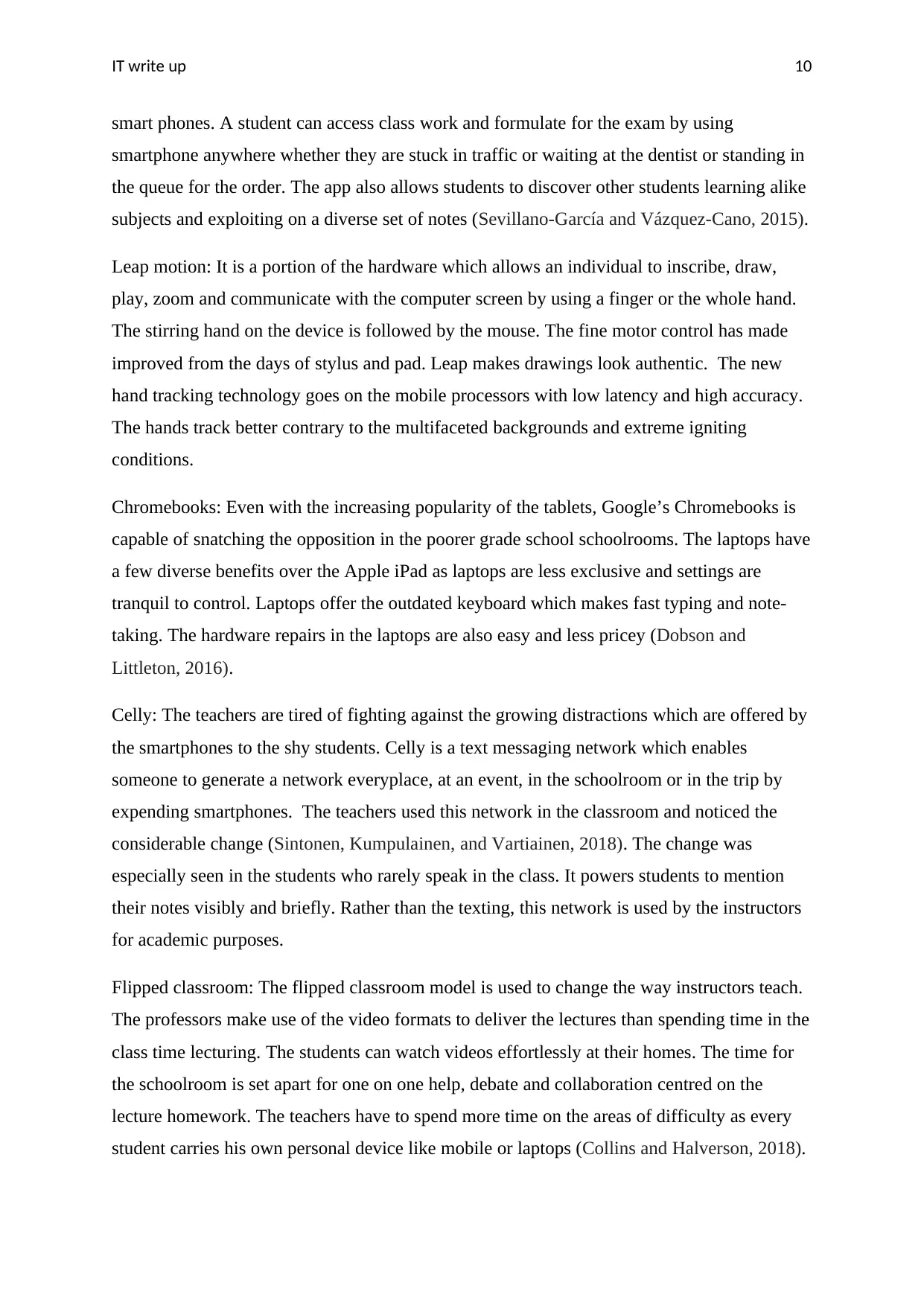
IT write up 10
smart phones. A student can access class work and formulate for the exam by using
smartphone anywhere whether they are stuck in traffic or waiting at the dentist or standing in
the queue for the order. The app also allows students to discover other students learning alike
subjects and exploiting on a diverse set of notes (Sevillano-García and Vázquez-Cano, 2015).
Leap motion: It is a portion of the hardware which allows an individual to inscribe, draw,
play, zoom and communicate with the computer screen by using a finger or the whole hand.
The stirring hand on the device is followed by the mouse. The fine motor control has made
improved from the days of stylus and pad. Leap makes drawings look authentic. The new
hand tracking technology goes on the mobile processors with low latency and high accuracy.
The hands track better contrary to the multifaceted backgrounds and extreme igniting
conditions.
Chromebooks: Even with the increasing popularity of the tablets, Google’s Chromebooks is
capable of snatching the opposition in the poorer grade school schoolrooms. The laptops have
a few diverse benefits over the Apple iPad as laptops are less exclusive and settings are
tranquil to control. Laptops offer the outdated keyboard which makes fast typing and note-
taking. The hardware repairs in the laptops are also easy and less pricey (Dobson and
Littleton, 2016).
Celly: The teachers are tired of fighting against the growing distractions which are offered by
the smartphones to the shy students. Celly is a text messaging network which enables
someone to generate a network everyplace, at an event, in the schoolroom or in the trip by
expending smartphones. The teachers used this network in the classroom and noticed the
considerable change (Sintonen, Kumpulainen, and Vartiainen, 2018). The change was
especially seen in the students who rarely speak in the class. It powers students to mention
their notes visibly and briefly. Rather than the texting, this network is used by the instructors
for academic purposes.
Flipped classroom: The flipped classroom model is used to change the way instructors teach.
The professors make use of the video formats to deliver the lectures than spending time in the
class time lecturing. The students can watch videos effortlessly at their homes. The time for
the schoolroom is set apart for one on one help, debate and collaboration centred on the
lecture homework. The teachers have to spend more time on the areas of difficulty as every
student carries his own personal device like mobile or laptops (Collins and Halverson, 2018).
smart phones. A student can access class work and formulate for the exam by using
smartphone anywhere whether they are stuck in traffic or waiting at the dentist or standing in
the queue for the order. The app also allows students to discover other students learning alike
subjects and exploiting on a diverse set of notes (Sevillano-García and Vázquez-Cano, 2015).
Leap motion: It is a portion of the hardware which allows an individual to inscribe, draw,
play, zoom and communicate with the computer screen by using a finger or the whole hand.
The stirring hand on the device is followed by the mouse. The fine motor control has made
improved from the days of stylus and pad. Leap makes drawings look authentic. The new
hand tracking technology goes on the mobile processors with low latency and high accuracy.
The hands track better contrary to the multifaceted backgrounds and extreme igniting
conditions.
Chromebooks: Even with the increasing popularity of the tablets, Google’s Chromebooks is
capable of snatching the opposition in the poorer grade school schoolrooms. The laptops have
a few diverse benefits over the Apple iPad as laptops are less exclusive and settings are
tranquil to control. Laptops offer the outdated keyboard which makes fast typing and note-
taking. The hardware repairs in the laptops are also easy and less pricey (Dobson and
Littleton, 2016).
Celly: The teachers are tired of fighting against the growing distractions which are offered by
the smartphones to the shy students. Celly is a text messaging network which enables
someone to generate a network everyplace, at an event, in the schoolroom or in the trip by
expending smartphones. The teachers used this network in the classroom and noticed the
considerable change (Sintonen, Kumpulainen, and Vartiainen, 2018). The change was
especially seen in the students who rarely speak in the class. It powers students to mention
their notes visibly and briefly. Rather than the texting, this network is used by the instructors
for academic purposes.
Flipped classroom: The flipped classroom model is used to change the way instructors teach.
The professors make use of the video formats to deliver the lectures than spending time in the
class time lecturing. The students can watch videos effortlessly at their homes. The time for
the schoolroom is set apart for one on one help, debate and collaboration centred on the
lecture homework. The teachers have to spend more time on the areas of difficulty as every
student carries his own personal device like mobile or laptops (Collins and Halverson, 2018).
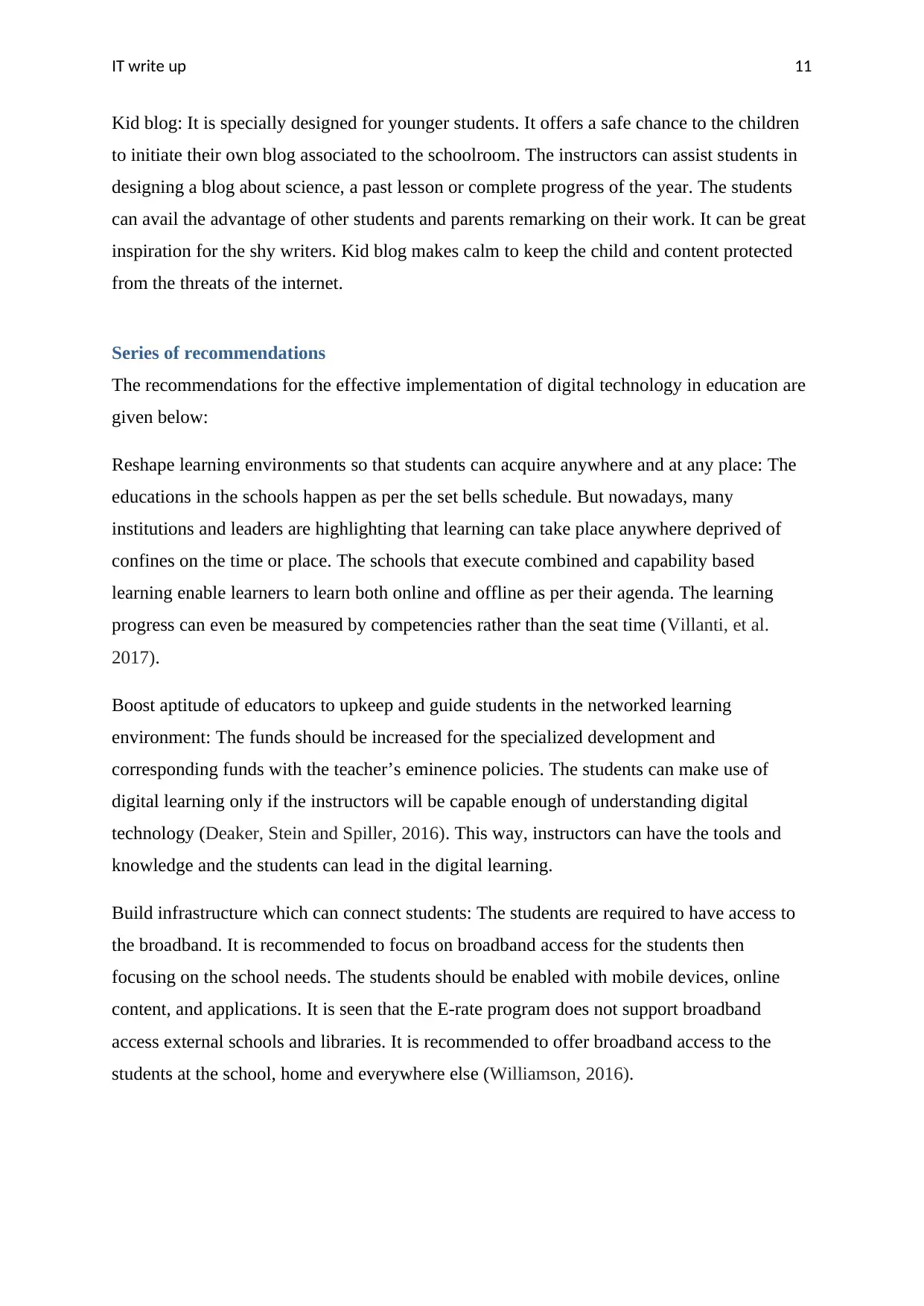
IT write up 11
Kid blog: It is specially designed for younger students. It offers a safe chance to the children
to initiate their own blog associated to the schoolroom. The instructors can assist students in
designing a blog about science, a past lesson or complete progress of the year. The students
can avail the advantage of other students and parents remarking on their work. It can be great
inspiration for the shy writers. Kid blog makes calm to keep the child and content protected
from the threats of the internet.
Series of recommendations
The recommendations for the effective implementation of digital technology in education are
given below:
Reshape learning environments so that students can acquire anywhere and at any place: The
educations in the schools happen as per the set bells schedule. But nowadays, many
institutions and leaders are highlighting that learning can take place anywhere deprived of
confines on the time or place. The schools that execute combined and capability based
learning enable learners to learn both online and offline as per their agenda. The learning
progress can even be measured by competencies rather than the seat time (Villanti, et al.
2017).
Boost aptitude of educators to upkeep and guide students in the networked learning
environment: The funds should be increased for the specialized development and
corresponding funds with the teacher’s eminence policies. The students can make use of
digital learning only if the instructors will be capable enough of understanding digital
technology (Deaker, Stein and Spiller, 2016). This way, instructors can have the tools and
knowledge and the students can lead in the digital learning.
Build infrastructure which can connect students: The students are required to have access to
the broadband. It is recommended to focus on broadband access for the students then
focusing on the school needs. The students should be enabled with mobile devices, online
content, and applications. It is seen that the E-rate program does not support broadband
access external schools and libraries. It is recommended to offer broadband access to the
students at the school, home and everywhere else (Williamson, 2016).
Kid blog: It is specially designed for younger students. It offers a safe chance to the children
to initiate their own blog associated to the schoolroom. The instructors can assist students in
designing a blog about science, a past lesson or complete progress of the year. The students
can avail the advantage of other students and parents remarking on their work. It can be great
inspiration for the shy writers. Kid blog makes calm to keep the child and content protected
from the threats of the internet.
Series of recommendations
The recommendations for the effective implementation of digital technology in education are
given below:
Reshape learning environments so that students can acquire anywhere and at any place: The
educations in the schools happen as per the set bells schedule. But nowadays, many
institutions and leaders are highlighting that learning can take place anywhere deprived of
confines on the time or place. The schools that execute combined and capability based
learning enable learners to learn both online and offline as per their agenda. The learning
progress can even be measured by competencies rather than the seat time (Villanti, et al.
2017).
Boost aptitude of educators to upkeep and guide students in the networked learning
environment: The funds should be increased for the specialized development and
corresponding funds with the teacher’s eminence policies. The students can make use of
digital learning only if the instructors will be capable enough of understanding digital
technology (Deaker, Stein and Spiller, 2016). This way, instructors can have the tools and
knowledge and the students can lead in the digital learning.
Build infrastructure which can connect students: The students are required to have access to
the broadband. It is recommended to focus on broadband access for the students then
focusing on the school needs. The students should be enabled with mobile devices, online
content, and applications. It is seen that the E-rate program does not support broadband
access external schools and libraries. It is recommended to offer broadband access to the
students at the school, home and everywhere else (Williamson, 2016).
⊘ This is a preview!⊘
Do you want full access?
Subscribe today to unlock all pages.

Trusted by 1+ million students worldwide
1 out of 16
Related Documents
Your All-in-One AI-Powered Toolkit for Academic Success.
+13062052269
info@desklib.com
Available 24*7 on WhatsApp / Email
![[object Object]](/_next/static/media/star-bottom.7253800d.svg)
Unlock your academic potential
Copyright © 2020–2025 A2Z Services. All Rights Reserved. Developed and managed by ZUCOL.





